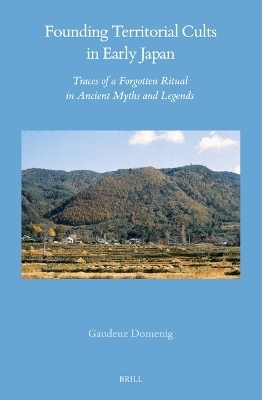
Founding Territorial Cults in Early Japan
Brill (Verlag)
978-90-04-68581-9 (ISBN)
The first book that deals with the territorial cults of early Japan by focusing on how such cults were founded in ownerless regions. Numerous ancient Japanese myths and legends are discussed to show that the typical founding ritual was a two-phase ritual that turned the territory into a horizontal microcosm, complete with its own ‘terrestrial heaven’ inhabited by local deities.
Reversing Mircea Eliade’s popular thesis, the author concludes that the concept of the human-made horizontal microcosm is not a reflection but the source of the religious concept of the macrocosm with gods dwelling high up in the sky.
The open access publication of this book has been published with the support of the Swiss National Science Foundation.
Gaudenz Domenig is an architect and researcher in anthropology of space who has mainly published on Japanese and Indonesian topics. His last book is Religion and Architecture in Premodern Indonesia (Brill, 2014).
Contents
Preface
List of Figures
Introduction
The Problem of the Pre-Shinto Cults
Territorial Cults
The Focus on Early Japan
Japan’s Protohistory
Innovations Introduced by the Taika Reform
Different Versions of the Same Story in Nihon Shoki
The God Age Mythology
The Fudoki Mythology
The Method of Interpretation
The Theoretical Model
The Structure of the Book
Various Notes
1 Divination
Divining with Things Thrown and Falling Down
Divining the Place for Founding a Shrine
Absurd Uses of the Falling Motif
Realistic Methods Exaggerated
Land Divination Typically Performed in Front
Divining with Things Cast Overboard
Floating a Wisteria Twig to Find the Right Place
Letting a Cooking Set Float to Enemy Land
Susanoo and the Floating Chopsticks
Kisakahime and the Lost Bow and Arrow
Articles to Play on the Sea
Floats Used for Divining
Divining in Boats
Later Survivals: The Religious Use of Wood Drifted Ashore
Conclusion
2 The Story of Yato no Kami
The Topography
The Mountain Entrance
The Lacking First Part of the Story
The Yashiro at the Upper Boundary
Matachi’s Ritual Procedure Reconstructed
Mibu no Muraji Maro and the Divine Snakes
Moving a Shrine to Another Site
The Location of the Ancient Pond
The New Conditions in the Ritsuryō State
Conclusions
3 Making a Large Territory in Harima
Ame no Hiboko and Iwa no Ōkami
Ame no Hiboko’s Arrival
The Claiming Ceremony on Iibo Hill
Other Claiming Stories
The Iibo Hill and Its Special Relation to the Iwa Jinja
Hardening the Land
A Model of the Grand-Scale Land-Making Myth?
The Two Foundations of the Iwa Shrine
Conclusions
4 Making and Ceding the Land in the God Age
The God Age Mythology: An Overview according to Kojiki
The Land-Making Myth
Sukunabikona
Ōnamuchi as a Beginner in Land-Making
The Land-Ceding Myth according to Kojiki
The Land-Ceding Myth according to Nihon Shoki
Kojiki and Nihon Shoki: Two Different Doctrines
Consequences of the Land-Ceding Myth
Conclusion
5 Ninigi’s Descent and His Territory in Kyushu
The Title Sentence Pattern
The Two Main Versions of the Myth
Cape Kasasa as a Place on the Way to Takachiho
Ninigi’s Arrival at the Coast
Ninigi Questions the Master of the Land at Cape Kasasa
Ninigi at Cape Kasasa
Takama no Hara as a Horizontally Distant Heaven
Ninigi’s Descendants Living in Kyushu
The Conquest of Yamato
Conclusion
6 The Foundation of the Izumo Shrine
Ōkuninushi’s Place of Hiding and Waiting
Prince Homuchiwake Worships the Great God of Izumo
Ashihara no Shikoo and the Worship at Iwakuma
Mt. Kannabi and the Sokinoya Shrine
A Suitable Site at the Foot of Mt. Kannabi
The Political Aspect
The Foundation of the Shrine at Kizuki
The Land-Pulling Myth and the Four Kannabi of Izumo
Summing Up
7 The Foundation of the Ise Shrine
The Later Version of the Foundation Story
Name-Asking as a Form of Claiming
Pillow Words Alluding to Land-Making Myths
The Topography of the Isuzu Valley
Sarutahiko and a Heaven in the Mountains
The Precinct of the Inner Shrine (Naikū)
From Simple to Complex Cult Systems
Sarutahiko’s Destiny
Summing Up
8 Characteristics of Territorial Cults
Divination as the Primary Rite
Variants of the Cult Contract
The Cult Contract and the State Ritual after the Taika Reform
Founder Worship
Shrine and Tomb
The Guardian Deity Is Excluded from the Land Opened Up
Nature Spirits Can Become Manifest in Wild Animals
The Guardian Deity Is Believed to Control the Local Weather
Calamities Blamed on Some Mistake in the Ritual
Cult Places Could Be Moved to Enlarge the Agricultural Land
The Mountain God as a Multifunctional Deity
The Mountain Entrance and the Torii
Boundary Marks
Tabooed Mountain Areas
The Bipolar Structure of Territories
The Chigi Cross as a Symbol
The Name of the Kami Land
The Age of the Yorishiro Concept
The Land-Making Motif in Creation Myths
Conclusion
9 Sacred Groves and Cult Marks
Yashikigami Worship
A Sacred Grove on Hirado Island
The Garō Yama of Tanegashima
The Sacred Forest of the Ōmiwa Shrine
The Matsushita Shrine and the Somin Sanctuary
Cult Marks Replaced by Shrine Buildings
Yorishiro and Ogishiro
The Shimenawa and the Straw Snake
Claiming Signs Made by Binding or Knotting Growing Plants
Pacifying the Site
Ancient Land-Claiming and the Rural Gathering Economy
Sign-Making Dealt with in Ethnographic Studies
10 Comparative Notes
The Settlement of Iceland
Founding Sacred Groves and Colonies in Ancient Greece
The Vedic Tradition
Opening Up Land in Shifting Cultivation
From Terrestrial Heavens to the Heaven in the Sky
Bibliography
Index
| Erscheinungsdatum | 29.12.2023 |
|---|---|
| Reihe/Serie | Brill's Japanese Studies Library ; 76 |
| Verlagsort | Leiden |
| Sprache | englisch |
| Maße | 155 x 235 mm |
| Gewicht | 750 g |
| Themenwelt | Geisteswissenschaften ► Geschichte ► Regional- / Ländergeschichte |
| Geisteswissenschaften ► Religion / Theologie ► Weitere Religionen | |
| Sozialwissenschaften ► Ethnologie | |
| Sozialwissenschaften ► Soziologie | |
| ISBN-10 | 90-04-68581-2 / 9004685812 |
| ISBN-13 | 978-90-04-68581-9 / 9789004685819 |
| Zustand | Neuware |
| Haben Sie eine Frage zum Produkt? |
aus dem Bereich


